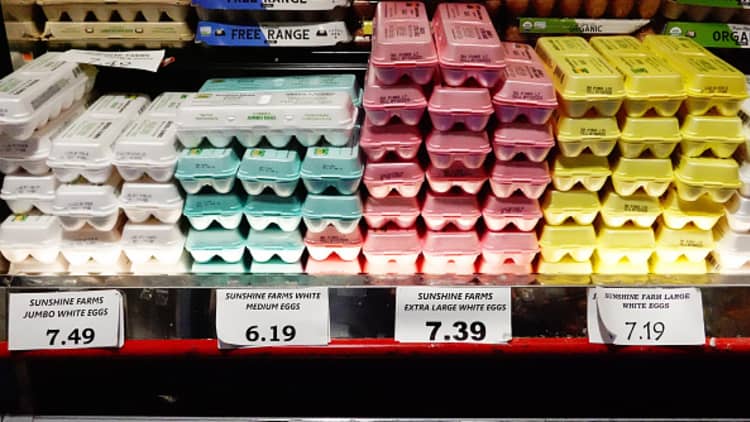
Matthew Hatcher | Afp | Getty Images
Retail egg prices retreated in February, according to federal data issued Tuesday, delivering relief to consumers who saw prices spike at the grocery store in recent months.
Average egg prices fell almost 7% in February relative to January, according to the consumer price index, a key barometer of inflation.
A dozen large Grade A eggs cost $4.21 in February, down 13% from $4.82 in January, which was a record high, according to federal data tracked by the Federal Reserve Bank of St. Louis. The monthly decline was the first since September.
Why egg prices increased rapidly
That dramatic increase in egg prices, economists say, largely stems from a disease called highly pathogenic avian influenza — known as bird flu.
The disease is contagious and lethal in birds. It killed a record number, including egg-laying hens, in 2022.
In past years, the virus has typically disappeared after the spring. It reappeared in the fall last year, crimping egg production while heading into peak demand season for eggs around the winter holidays, experts said.

Lower prices now partly reflect a decline in consumer demand early in the year, which is a typical seasonal pattern, said Brian Moscogiuri, a global trade strategist at Eggs Unlimited, an egg supplier.
There also hasn’t been a new confirmed case of avian flu among commercial table-egg farms since December, giving suppliers some time to recover.
“Do we expect crazy, record pricing again? No,” Moscogiuri said.
Egg prices may pop again around Easter
However, prices may rise again heading into Easter, which is in April, due to generally strong demand around that holiday, experts said. There’s also a chance that bird flu could surface again at egg farms.
General inflationary pressures are also serving to keep egg prices elevated. Those include higher corn and soybean prices, which make it more costly to feed hens, and costs for labor and transportation, Moscogiuri said.
Average wholesale egg prices increased 16% so far in March, according to Angel Rubio, senior analyst at Urner Barry, which tracks the wholesale market.
It generally takes about a month for those prices to trickle through to consumers, and the price moves are often more muted, Rubio said.
Ultimately, retailers such as grocery stores determine the timing and amount of the price increase for consumers.

